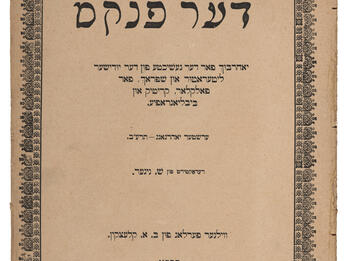Jewish Liturgy: A Comprehensive History
The task of this book was determined by its being part of the Grundriß [der Gesamtwissenschaft des Judentums; Fundamental Study toward the Comprehensive Knowledge of Judaism] series. Based on scholarly research, but without exhausting itself in detail and without assuming expert knowledge on the part of the reader, it had to offer a comprehensive and systematic presentation of the subject; it had to establish its importance not so much through the quantity and newness of individual insights but through the delineation of an overall picture. Hence it emphasizes lucidity and clarity of structure; it pays particular attention to the precise definition of its terminology and the explanation of all technical terms. There is no lack of earlier works in our field, but as far as I can see, they all focus on details and deal thoroughly with the many prayers and customs, but do not create an overview. In contrast, my effort was focused on offering a vivid and concrete picture of the prayer service as an integral whole. The scholarly elucidation of details cannot be underestimated for the understanding of the service and lends the right coloration to the overall picture. It has been integrated by way of the best sources, but has not been allowed to become an end in itself; it was curtailed so as not to disturb the symmetry of the whole. Particularly in the section about the organization it was important to integrate extraneous matter only to the degree that it is absolutely necessary in order to create a full presentation of the prayer service. The selection and demarcations may seem arbitrary to some readers; the specialist may consider many things superfluous and may miss others that are important to him. Of course, much will be amiss, but in this first effort the emphasis is not on the details but on the basic structure and on the execution of the overall plan.
The effort to comprehend the prayer service as a unit and to depict it as such has led to a deviation from traditional scholarship in yet another area. In earlier works and in the minds of colleagues in the field, the piyut is preeminent. This is not case in the present book. Whoever opens it with the expectation to find a complete listing of paytanim und piyutim will be very disappointed. Such an overview is part of literary history; in this book the poets and their works are noted only to the extent to which they influenced the shape of the liturgy. If one looks beyond the sphere of the German rite and does not permit the quarrels of the nineteenth century to cloud one’s judgment, one is forced to step back from the current overestimation of the importance of the piyyut for the liturgy. It is the basic stock of prayers, the core prayers, that are here given most attention, especially their development in the earliest time, of which our deepening acquaintance with the old Palestinian rite affords us an increasingly clearer appreciation. Much still remains unilluminated; it would be a real benefit for scholarship if the unsolved problems stimulated further research into the core prayers. Substantial attention was paid to modernity not only because we are close to it and the continuing quarrels constantly alert us to its tendencies, but also because after a very long period of stasis an attempt is being made, after more than a thousand years, at real development and redesign in order to produce a historically aware way of life. Not all readers will share my assessment of the [historical] facts; many will consider it partisan; but I am confident that even those among the readers who arrive at a different point of view, will recognize my effort to maintain scientific objectivity.
The book assumes that the reader has a prayer book at hand and is familiar with its content; yet it wants to be neither a commentary nor a list of its sources, but an aid to understanding development and organization of the liturgy. The information it contains about the deviation of individual prayers was collected with the intent to showcase the possibly oldest form of the prayers and of the liturgical arrangements. Presenting an abundant mass of details was prohibited by the desire to present all of the material in one volume.
The presentation of the liturgy covers the entire geographic area in which it developed. However, it happened quite naturally that the tradition that reigns in Germany furnished the foundation and was given special attention, not least because it is followed by the majority of Jews. However, no sizable ritual group was ignored; the most important prayer books of all countries were examined.
The text is supplemented by notes. They are also kept short and do not exceed the length appropriate for a basic work. The notes relate closely to the text; they contain source material to justify the cited facts and justifications for the views offered in the text. The notes also point the reader to dissenting views. Polemics were avoided in most cases. In addition, the notes offer citations of specialized research missing from the list of the most important monographs presented before each section. For the sake of brevity, the reader is often directed to comprehensive works, such as Schürer’s History or the Jewish Encyclopedia,1 which offer rich bibliographies.
Notes
[Emil Schürer (1844–1910), German Protestant scholar who wrote Geschichte des jüdischen Volkes im Zeitalter Jesu Christi (1874–1909). The 12-volume Jewish Encyclopedia (1901–1906) was edited by Cyrus Adler et al.—Trans.]
Credits
Published in: The Posen Library of Jewish Culture and Civilization, vol. 7.



